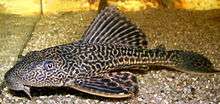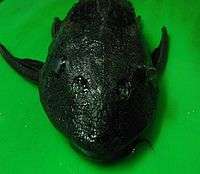Pterygoplichthys multiradiatus
| Pterygoplichthys multiradius | |
|---|---|
 | |
| Not evaluated (IUCN 3.1) | |
| Scientific classification | |
| Kingdom: | Animalia |
| Phylum: | Chordata |
| Class: | Actinopterygii |
| Order: | Siluriformes |
| Family: | Loricariidae |
| Genus: | Pterygoplichthys |
| Species: | P. multiradiatus |
| Binomial name | |
| Pterygoplichthys "spoked" multiradiatus (Hancock, 1828) | |
Pterygoplichthys multiradiatus is one of several tropical fish commonly known as plecostomus (or plecos). It belongs to the armored catfish family (Loricariidae). Named for its sail-like dorsal fin, the part of its scientific name multiradiatus means "many-rayed" and refers to the rays of the dorsal fin. P. multiradiatus is one of a number of species commonly referred to as the common pleco by aquarists.[1]
Other scientific names that were used (as synonyms) for P. multiradiatus include Hypostomus multiradiatus, Ancistrus multiradiatus, and Liposarcus multiradiatus. P. multiradiatus is sometimes confused with Pterygoplichthys pardalis, which is a different species of pleco. P. multiradiatus goes by a number of common names. It can be called the "long-fin armored catfish" in Hawaii, "sailfin catfish", "sailfish catfish", "many-rayed (multiradiatus) pleco" or "radiated ptero" in the United States, 多輻翼甲鯰 in Mandarin Chinese and janitor fish in the Philippines, where it has become a local pest in the Marikina River and is sold in bulk, in efforts to eliminate the fish. P. multiradiatus is mottled brown/black and inhabits freshwater streams and lakes and in weedy, mud-bottomed canals in its native habitat: the Orinoco River basin in Venezuela. Its geographic distribution is 10°N - 1°N, 68°W - 61°W. This tropical, nocturnal bottom-dweller likes warm water at the temperature range of 23–27 °C, pH range: 6.5–7.8, and dH range: 4–20.
P. multiradiatus browses on substrate, mainly feeding on benthic algae and aquatic weeds, but will also take worms, insect larvae and other bottom-dwelling invertebrates as food.
One of the large plecos (growing to a maximum of 50.0 centimetres (19.7 in) TL), this species likes solitude, is relatively peaceful as an aquarium fish and does well with cichlids and other big fish, and should be kept in large tanks only and with plenty of rocks and driftwood in which to hide.
P. multiradiatus is not of interest in the fisheries, but is very important, as with many other plecos, in the aquarium trade.
This species has been introduced to Hawaii (Maui, Oahu, Hawaii and Kauai islands), Puerto Rico, Vietnam, Bangladesh, México, and Florida,[2] and has now established itself (accidentally or by release of aquarium specimens) in Kerala, S. India, Sri Lanka and The Philippines among other locations where it is regarded as a harmful invasive species being relatively inedible to people and predators, causing damage to fishing gear, competing and harming against native species and disrupting environments by its burrowing activities. In this context its relative, Hypostomus plecostomus, has also been similarly implicated though it seems likely that in Asia, both or related species are implicated.

See also
References
- "Liposarcus multiradiatus". Integrated Taxonomic Information System. Retrieved 4 March 2007.
- "Pterygoplichthys multiradiatus". Integrated Taxonomic Information System. Retrieved 4 March 2007.
- ↑ Froese, Rainer and Pauly, Daniel, eds. (2011). "Pterygoplichthys multiradiatus" in FishBase. December 2011 version.
- ↑ LUCY BUNKLEY-WILLIAMS, ERNEST H. WILLIAMS, JR., CRAIG G. LILYSTROM, IRIS CORUJO -FLORES, ALFONSO J. ZERBI, CATHERINE ALIAUME, AND TIMOTHY N. CHURCHILL. (1994). "The South American Sailfin Armored Catfish, Liposarcus multiradiatus (Hancock), a New Exotic Established in Puerto Rican Fresh Waters" (PDF). Caribbean Journal of Science.